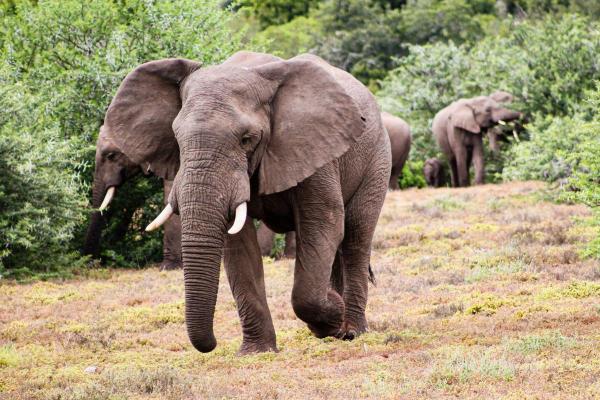Why Can't Elephants Jump? -


While their size might suggest otherwise, elephants possess a surprising grace and agility in their movements, navigating their surroundings with unexpected ease. In fact, elephants showcase a diverse range of movements, and are able to climb and swim. Yet, one movement eludes them: the ability to jump. While their weight undoubtedly plays a role in this limitation, the reasons extend beyond mere size.
In this AnimalWised exploration, we explore why elephants cannot jump and take a closer look at the various ways they move.
How do elephants move?
Elephants are the largest land animals on Earth, and their unique anatomy allows them to move in a variety of ways. Despite their massive size, elephants can be surprisingly agile and graceful in their movements.
Elephants typically walk at a speed of about 4-6 km/h (2.5-4 mph), but they can reach speeds of up to 40 km/h (25 mph) when charging or running short distances. Their legs act as pendulums, with the hips and shoulders moving up and down while the foot is planted on the ground. This pendulum-like motion allows them to conserve energy and move efficiently over long distances.
Elephants can also move at a faster gait known as an amble, which is similar to a run but with less vertical movement. In an amble, the elephant's legs move in a rotary motion, allowing them to cover ground more quickly while still maintaining stability.
Furthermore, they are also excellent swimmers. Elephants use their powerful legs to paddle through the water, and their trunk can act as a snorkel, allowing them to breathe while submerged. Elephants can swim for long distances and have been known to cross rivers and even oceans.
Finally, they are surprisingly good climbers and can navigate steep slopes and rocky terrain with ease. They use their strong legs and trunks to grip and pull themselves up, and their large feet provide a stable base.
In general, elephants have a remarkable sense of balance, which allows them to stand on their hind legs, walk on narrow beams, and even balance on one leg. Their large feet and wide stance provide a stable base, and their trunk can act as a counterbalance.
Can elephants jump?
No, elephants cannot jump. Their anatomy is not suited for jumping, and they do not need to jump to survive. Elephants are the largest land animals on Earth, and their massive weight makes it difficult for them to get off the ground.
Elephants' bodies are full of surprises, even when it comes to sleep. Explore the fascinating ways elephants sleep, from their sleeping positions to their remarkable ability to snooze while standing, in our article on how elephants sleep.

Why can't elephants jump?
Elephants, the largest land mammals on Earth, are known for their impressive size, strength, and intelligence. However, despite their remarkable abilities, elephants lack the capacity to jump. This inability to jump stems from a combination of anatomical and evolutionary factors.
Firstly, elephants are incredibly heavy animals, with adult males weighing up to 6,000 kg (13,200 lb). This immense weight poses a significant challenge for jumping, as it requires generating enough force to lift their entire body off the ground.
Furthermore, elephants have straight, pillar-like legs that provide stability and support for their massive weight. However, this leg structure lacks the flexibility and spring-like action necessary for jumping. Their leg bones are positioned directly below their body, rather than angled like in jumping animals, further limiting their ability to generate lift.
Not only that, but elephants have relatively weak ankles compared to their overall size. The ankle joint plays a crucial role in jumping, storing and releasing energy to propel the body upwards. The weakness of elephant ankles makes it difficult for them to withstand the forces involved in jumping, increasing the risk of injury.
Besides their physical limitations, it is also worth mentioning that elephants have evolved to thrive in their environment without the need for jumping. They can reach food and water sources without jumping, and their large size and strength provide effective defense mechanisms against predators.
In this sense, jumping would not provide significant benefits for their survival and could even pose risks due to their weight and leg structure. Their anatomy is better suited for stability, strength, and endurance, allowing them to navigate their environment effectively without the need for jumping.
Did you know that elephants can 'talk' to each other using low-frequency rumbles that travel for miles? Their communication skills are as remarkable as their size. Unravel the mysteries of elephant communication and discover the diverse ways they exchange information in our other article.
Do elephants have knees?
Yes, elephants do have knees, but they only have two, located on their hind legs. The front legs of elephants, like those of other four-legged mammals, have elbows instead of knees. The knee joint is a hinge-like structure that allows the leg to bend and straighten, providing flexibility and support for movement.
Elephant knees are similar in structure to human knees, with a patella (kneecap) and ligaments that connect the femur (thigh bone) to the tibia (shin bone). However, elephant knees are much larger and stronger to support their massive weight. The patella in elephants is embedded within a tendon, providing additional stability and protection for the joint.
Elephant knees play a crucial role in their locomotion, allowing them to walk, run, and even kneel down. The flexibility of the knee joint enables elephants to navigate various terrains and maintain balance while carrying their weight. The strength of the knee joint ensures that it can withstand the forces involved in movement and support the elephant's massive body.
Did you know that not all elephants have tusks? Just like their unique anatomy that hinders jumping, the presence or absence of tusks offers fascinating insights into their evolution. Check out this other article where we dig into whether all elephants have tusks.

If you want to read similar articles to Why Can't Elephants Jump? -, we recommend you visit our Facts about the animal kingdom category.
- Genin, JJ, Willems, PA, Cavagna, GA, Lair, R., & Heglund, NC (2010). Biomechanics of locomotion in Asian elephants. Journal of Experimental Biology , 213 (5), 694-706.
- Royal Veterinary College. (1998). Biomechanical Research Revealing Elephants Move Like 4x4 Vehicles .
- Ren, L., Miller, C.E., Lair, R., & Hutchinson, JR (2010). Integration of biomechanical compliance, leverage, and power in elephant limbs. Proceedings of the National Academy of Sciences , 107 (15), 7078-7082.
- Weissengruber, GE, Fuss, FK, Egger, G., Stanek, G., Hittmair, KM, & Forstenpointner, G. (2006). The elephant knee joint: morphological and biomechanical considerations. Journal of Anatomy , 208 (1), 59-72.







